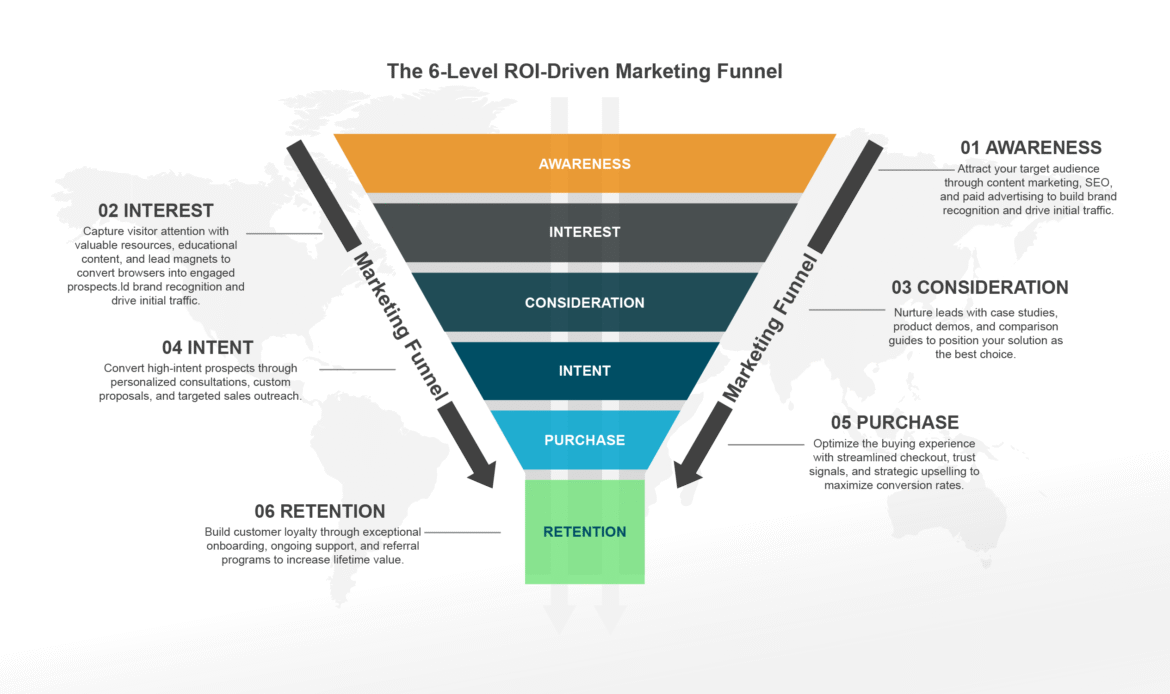Introduction: Why Most Marketing Funnels Fail to Deliver ROI
Picture this: You've spent thousands on marketing campaigns, generated hundreds of leads, but your revenue remains flat. Sound familiar? You're not alone. Studies show that 68% of businesses haven't identified their funnel conversion rates, and only 22% are satisfied with their current conversion performance.
The problem isn't traffic—it's strategy. Most marketers build funnels based on assumptions rather than data-driven insights. While we previously covered the fundamentals of ROI-driven marketing funnels, this comprehensive guide takes a deeper dive into advanced strategies, implementation tactics, and optimization techniques that will help you construct a marketing funnel that not only converts but delivers measurable ROI at every stage.

What Makes a Marketing Funnel ROI-Driven?
An ROI-driven marketing funnel differs from traditional funnels in three critical ways:
- Data-Centric Decision Making: Every element is tested, measured, and optimized based on performance metrics
- Revenue Attribution: Clear tracking of how each touchpoint contributes to revenue
- Continuous Optimization: Regular analysis and refinement based on real user behavior
Unlike generic funnels that focus solely on moving prospects through stages, ROI-driven funnels prioritize profitability and sustainable growth.
The Three-Stage Framework: TOFU, MOFU, BOFU Explained
Stage 1: TOFU (Top of Funnel) - Awareness Phase
Primary Goal: Attract high-quality prospects and build brand awareness
Target Audience Characteristics:
- Problem-aware but solution-unaware
- Seeking educational content
- Early in their buyer's journey
- High intent to learn, low intent to purchase
Content Strategy:
- Blog Posts: SEO-optimized articles addressing pain points
- Social Media Content: Engaging posts that spark conversations
- Video Content: Educational tutorials and industry insights
- Infographics: Data-driven visual content
- Podcasts: Thought leadership discussions
- Free Tools: Calculators, templates, and assessments
Key Metrics to Track:
- Organic traffic growth
- Social media engagement rates
- Content consumption metrics (time on page, scroll depth)
- Email subscriber growth
- Brand awareness surveys
Sample TOFU Content Calendar:
- Monday: Industry news analysis
- Wednesday: How-to tutorial
- Friday: Tool/resource roundup
Stage 2: MOFU (Middle of Funnel) - Consideration Phase
Primary Goal: Nurture leads and position your solution as the best option
Target Audience Characteristics:
- Solution-aware and comparing options
- Engaged with your content regularly
- Requesting more detailed information
- Showing buying signals
Content Strategy:
- Case Studies: Real customer success stories with metrics
- Webinars: Deep-dive educational sessions
- Comparison Guides: Your solution vs. competitors
- Email Sequences: Nurturing campaigns with value-driven content
- White Papers: Industry research and insights
- Product Demos: Feature-focused presentations
Lead Nurturing Sequence Example:
- Welcome email with valuable resource
- Educational content (3-5 emails)
- Social proof (testimonials, case studies)
- Soft product introduction
- Comparison content
- Objection handling
- Consultation offer
Key Metrics to Track:
- Lead conversion rates
- Email open and click-through rates
- Webinar attendance and engagement
- Content download rates
- Lead scoring progression
Stage 3: BOFU (Bottom of Funnel) - Decision Phase
Primary Goal: Convert qualified leads into paying customers
Target Audience Characteristics:
- Ready to make a purchasing decision
- Evaluating final options
- Seeking proof and reassurance
- Price and feature sensitive
Content Strategy:
- Free Trials: Risk-free product experience
- Consultations: Personalized solution discussions
- Testimonials: Customer success stories
- Pricing Information: Clear, transparent pricing
- Limited-Time Offers: Urgency-driven promotions
- ROI Calculators: Demonstrate value proposition
Key Metrics to Track:
- Sales conversion rates
- Average deal size
- Sales cycle length
- Customer acquisition cost (CAC)
- Customer lifetime value (CLV)
Advanced Funnel Optimization Strategies
1. Multi-Channel Attribution Modeling
Understanding which touchpoints contribute to conversions is crucial for ROI optimization. Implement these attribution models:
- First-Touch Attribution: Credits the first interaction
- Last-Touch Attribution: Credits the final interaction before conversion
- Linear Attribution: Distributes credit equally across all touchpoints
- Time-Decay Attribution: Gives more credit to recent interactions
2. Behavioral Segmentation
Segment your audience based on:
- Engagement Level: High, medium, low engagement
- Content Preferences: Video watchers, blog readers, webinar attendees
- Purchase Intent: High-intent vs. research-mode prospects
- Demographics: Industry, company size, role
3. Personalization at Scale
Implement dynamic content based on:
- Previous content consumed
- Industry or company size
- Stage in the funnel
- Geographic location
- Device type
Essential Tools and Technology Stack
1. Analytics and Tracking
- Google Analytics 4: Comprehensive website analytics
- Hotjar: User behavior analysis and heatmaps
- Mixpanel: Event-based analytics for detailed user journeys
- Attribution Tools: Bizible, Ruler Analytics, or HubSpot Attribution
2. Marketing Automation
- Email Marketing: Mailchimp, ConvertKit, or HubSpot
- CRM Integration: Salesforce, HubSpot, or Pipedrive
- Social Media Management: Hootsuite, Buffer, or Sprout Social
3. Conversion Optimization
- A/B Testing: Optimizely, VWO, or Google Optimize
- Landing Page Builders: Unbounce, Leadpages, or Instapage
- Form Optimization: Typeform, JotForm, or Gravity Forms
Measuring ROI: Key Metrics and KPIs
1. TOFU Metrics
- Cost Per Click (CPC): Average cost to drive traffic
- Cost Per Visitor: Total marketing spend ÷ website visitors
- Engagement Rate: Time on site, pages per session
- Content Performance: Shares, comments, backlinks
2. MOFU Metrics
- Lead Conversion Rate: Visitors to leads percentage
- Cost Per Lead (CPL): Marketing spend ÷ number of leads
- Lead Quality Score: Based on engagement and fit
- Nurturing Efficiency: Email engagement and progression rates
3. BOFU Metrics
- Sales Conversion Rate: Leads to customers percentage
- Customer Acquisition Cost (CAC): Total sales and marketing spend ÷ new customers
- Average Order Value (AOV): Revenue ÷ number of orders
- Customer Lifetime Value (CLV): Predicted revenue from a customer relationship
Overall ROI Calculation
- Marketing ROI = (Revenue - Marketing Investment) ÷ Marketing Investment × 100
Common Funnel Leaks and How to Fix Them
1. Traffic Quality Issues
- Problem: High traffic, low engagement
- Solution: Refine targeting, improve content relevance, optimize for search intent
2. Lead Conversion Bottlenecks
- Problem: Visitors aren't converting to leads
- Solution: Improve lead magnets, optimize forms, test different offers
3. Nurturing Sequence Failures
- Problem: Leads go cold during nurturing
- Solution: Segment email lists, personalize content, improve timing
4. Sales Conversion Obstacles
- Problem: Qualified leads aren't buying
- Solution: Address objections, improve sales process, provide social proof
Step-by-Step Implementation Guide
Week 1-2: Foundation Setup
- Install analytics and tracking tools
- Define buyer personas and journey stages
- Audit existing content and identify gaps
- Set up basic email automation
Week 3-4: Content Creation
- Develop TOFU content calendar
- Create lead magnets for each stage
- Write email nurturing sequences
- Produce sales-focused content
Week 5-6: Launch and Test
- Launch updated funnel
- Set up A/B tests for key elements
- Monitor initial performance
- Gather user feedback
Week 7-8: Optimization
- Analyze performance data
- Implement improvements
- Scale successful elements
- Plan next iteration
Real-World Case Study: SaaS Company Transformation
Challenge: A B2B SaaS company with 10,000 monthly visitors but only 2% conversion rate
Solution Implemented:
- Redesigned lead magnets specific to each buyer persona
- Implemented behavioral email sequences
- Added retargeting campaigns
- Optimized pricing page with social proof
Results After 3 Months:
- Lead conversion rate: 2% → 6.5%
- Sales conversion rate: 8% → 15%
- Customer acquisition cost: $450 → $280
- Overall ROI: 185% increase
Advanced Strategies for Scaling
1. Account-Based Marketing Integration
Target high-value accounts with personalized funnel experiences
2. Predictive Analytics
Use AI to identify high-conversion probability prospects
3. Cross-Channel Orchestration
Coordinate messaging across email, social, ads, and direct sales
4. Customer Journey Optimization
Continuously refine the post-purchase experience to increase CLV
Conclusion: Building Your ROI-Driven Marketing Machine
Creating a truly ROI-driven marketing funnel requires more than just understanding the stages—it demands a commitment to data-driven decision making, continuous testing, and customer-centric thinking.
The most successful companies don't just build funnels; they build systems that learn, adapt, and improve over time. By implementing the strategies outlined in this guide, you'll create a marketing funnel that not only converts prospects into customers but builds sustainable, profitable growth.
Remember: The goal isn't just to move people through your funnel—it's to create experiences so valuable that customers become advocates, driving organic growth and reducing your overall acquisition costs.
Start with the fundamentals, measure everything, and optimize relentlessly. Your bottom line will thank you.
Frequently Asked Questions (FAQ)
Q: How long does it take to see results from a new marketing funnel?
A: Most businesses see initial improvements within 4-6 weeks, with significant results appearing after 3-6 months of consistent optimization.
Q: What's the biggest mistake companies make with their marketing funnels?
A: The biggest mistake is building funnels based on assumptions rather than data. Always test and validate before scaling.
Q: How much should I budget for marketing funnel tools?
A: Start with basic tools (under $200/month) and scale your tech stack as you grow. Most essential tools offer free tiers for small businesses.
Q: Can this approach work for B2C businesses?
A: Absolutely. While the content types may differ, the principle of ROI-driven optimization applies to both B2B and B2C companies.
Ready to automate and accelerate your growth? Let’s upscale together on the Upsworth



1 reply on “How to Build a High-Converting ROI-Driven Marketing Funnel in 2025: A Complete Guide”
[…] Optimization: E-commerce viral campaigns must connect to optimized sales funnels that maximize ROI from viral traffic. Without proper conversion tracking and optimization, viral buzz may not […]